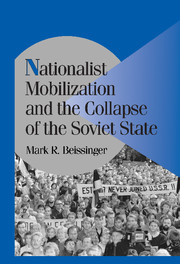Book contents
- Frontmatter
- Contents
- Illustrations
- Tables
- Acknowledgments
- 1 FROM THE IMPOSSIBLE TO THE INEVITABLE
- 2 THE TIDE OF NATIONALISM AND THE MOBILIZATIONAL CYCLE
- 3 STRUCTURING NATIONALISM
- 4 “THICKENED” HISTORY AND THE MOBILIZATION OF IDENTITY
- 5 TIDES AND THE FAILURE OF NATIONALIST MOBILIZATION
- 6 VIOLENCE AND TIDES OF NATIONALISM
- 7 THE TRANSCENDENCE OF REGIMES OF REPRESSION
- 8 RUSSIAN MOBILIZATION AND THE ACCUMULATING “INEVITABILITY” OF SOVIET COLLAPSE
- 9 CONCLUSION: NATIONHOOD AND EVENT
- Appendix I PROCEDURES FOR APPLYING EVENT ANALYSIS TO THE STUDY OF SOVIET PROTEST IN THE GLASNOST' ERA
- Appendix II SOURCES FOR THE COMPILATION OF EVENT DATA IN A REVOLUTIONARY CONTEXT
- Index
- Titles in the series
6 - VIOLENCE AND TIDES OF NATIONALISM
Published online by Cambridge University Press: 18 November 2009
- Frontmatter
- Contents
- Illustrations
- Tables
- Acknowledgments
- 1 FROM THE IMPOSSIBLE TO THE INEVITABLE
- 2 THE TIDE OF NATIONALISM AND THE MOBILIZATIONAL CYCLE
- 3 STRUCTURING NATIONALISM
- 4 “THICKENED” HISTORY AND THE MOBILIZATION OF IDENTITY
- 5 TIDES AND THE FAILURE OF NATIONALIST MOBILIZATION
- 6 VIOLENCE AND TIDES OF NATIONALISM
- 7 THE TRANSCENDENCE OF REGIMES OF REPRESSION
- 8 RUSSIAN MOBILIZATION AND THE ACCUMULATING “INEVITABILITY” OF SOVIET COLLAPSE
- 9 CONCLUSION: NATIONHOOD AND EVENT
- Appendix I PROCEDURES FOR APPLYING EVENT ANALYSIS TO THE STUDY OF SOVIET PROTEST IN THE GLASNOST' ERA
- Appendix II SOURCES FOR THE COMPILATION OF EVENT DATA IN A REVOLUTIONARY CONTEXT
- Index
- Titles in the series
Summary
So great was the confusion of those years; so difficult was it at the moment when “humanity” was being re-evaluated, to determine the place madness was to occupy within it; so difficult was it to situate madness in a social sphere that was being restructured.
Michel Foucault, Madness and CivilizationNationalism in and of itself is neither a social good nor a social evil. Rather, our moral judgments concerning nationalism emerge from what agents do in the name of the nation. Nationalism thus cannot be understood as only a “state of mind” or “political principle.” It is also a way of comporting oneself, a motivated collection of actions and discourses, and, in the totality of acts that it involves, a repertoire of behaviors oriented toward a specific set of objects. Within this repertoire of nationalist behaviors, violence assumes a special place. Violence has been visibly prominent in the history of nationalism since its inception in the revolutions of the seventeenth and eighteenth centuries. It remains pronounced as well in the “ethnic cleansing” and civil wars which continue to rack portions of the planet.
Most generic theories of nationalism have had little to say about the relationship between nationalism and violence. They have been much more interested in issues of identity than in what is done in the name of the nation (as if action flowed logically from holding a particular identity position). This has not inhibited the growth of a large cottage industry focused on explaining nationalist violence.
- Type
- Chapter
- Information
- Nationalist Mobilization and the Collapse of the Soviet State , pp. 271 - 319Publisher: Cambridge University PressPrint publication year: 2002

